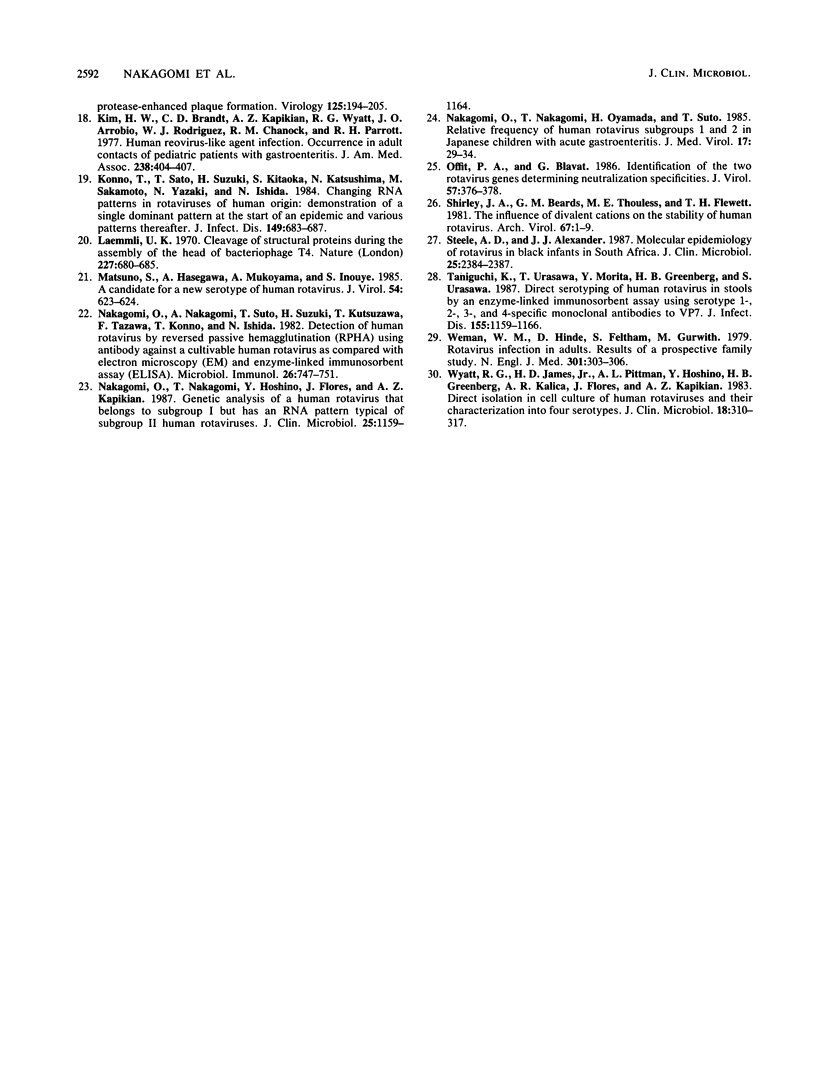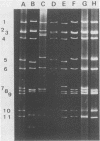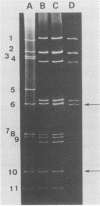Abstract
To investigate the serotypic and genetic diversity of human rotavirus strains, we have tested 513 and 519 fecal rotavirus specimens, respectively, by an enzyme-linked immunosorbent assay with serotype-specific monoclonal antibodies and by polyacrylamide gel electrophoresis of the segmented RNA genome. Of the 513 specimens, 375 were typed as serotype 1 (47.3%), serotype 2 (2.9%), serotype 3 (2.9%), or serotype 4 (17.7%). In addition, a presumptive new human serotype, tentatively referred to as serotype X in this paper, was found in 1.6% of the specimens tested. The remaining 138 specimens (26.9%) were untypeable. Considerable variation in relative frequency of circulating serotypes was observed with respect to geographic locations and observation periods. Rotavirus RNAs were visualized in 481 of 519 specimens tested. Of these, 415 were typed as 33 electropherotypes, many of which were infrequently detected and were restricted to single epidemics. Analysis of the 291 specimens whose electropherotypes and serotypes were available indicated clearly that a given RNA pattern always corresponded to a particular serotype. Heterogeneity of electropherotypes within a serotype was similarly observed in strains belonging to the four previously established serotypes. The results obtained in this study indicated that antigenic changes on the major neutralization antigen occurred always with concurrent changes of genomic RNA electropherotypes. On the other hand, serotypic changes could not be predicted from the changes in RNA electropherotypes.
Full text
PDF






Images in this article
Selected References
These references are in PubMed. This may not be the complete list of references from this article.
- Beards G. M., Pilfold J. N., Thouless M. E., Flewett T. H. Rotavirus serotypes by serum neutralisation. J Med Virol. 1980;5(3):231–237. doi: 10.1002/jmv.1890050307. [DOI] [PubMed] [Google Scholar]
- Beards G. M. Polymorphism of genomic RNAs within rotavirus serotypes and subgroups. Arch Virol. 1982;74(1):65–70. doi: 10.1007/BF01320783. [DOI] [PubMed] [Google Scholar]
- Birch C. J., Heath R. L., Gust I. D. Use of serotype-specific monoclonal antibodies to study the epidemiology of rotavirus infection. J Med Virol. 1988 Jan;24(1):45–53. doi: 10.1002/jmv.1890240107. [DOI] [PubMed] [Google Scholar]
- Clark H. F., Hoshino Y., Bell L. M., Groff J., Hess G., Bachman P., Offit P. A. Rotavirus isolate WI61 representing a presumptive new human serotype. J Clin Microbiol. 1987 Sep;25(9):1757–1762. doi: 10.1128/jcm.25.9.1757-1762.1987. [DOI] [PMC free article] [PubMed] [Google Scholar]
- Clarke I. N., McCrae M. A. Structural analysis of electrophoretic variation in the genome profiles of rotavirus field isolates. Infect Immun. 1982 May;36(2):492–497. doi: 10.1128/iai.36.2.492-497.1982. [DOI] [PMC free article] [PubMed] [Google Scholar]
- Coulson B. S., Unicomb L. E., Pitson G. A., Bishop R. F. Simple and specific enzyme immunoassay using monoclonal antibodies for serotyping human rotaviruses. J Clin Microbiol. 1987 Mar;25(3):509–515. doi: 10.1128/jcm.25.3.509-515.1987. [DOI] [PMC free article] [PubMed] [Google Scholar]
- Coulson B. S. Variation in neutralization epitopes of human rotaviruses in relation to genomic RNA polymorphism. Virology. 1987 Aug;159(2):209–216. doi: 10.1016/0042-6822(87)90457-0. [DOI] [PubMed] [Google Scholar]
- Estes M. K., Graham D. Y., Dimitrov D. H. The molecular epidemiology of rotavirus gastroenteritis. Prog Med Virol. 1984;29:1–22. [PubMed] [Google Scholar]
- Flores J., Nakagomi O., Nakagomi T., Glass R., Gorziglia M., Askaa J., Hoshino Y., Perez-Schael I., Kapikian A. Z. The role of rotaviruses in pediatric diarrhea. Pediatr Infect Dis. 1986 Jan-Feb;5(1 Suppl):S53–S62. doi: 10.1097/00006454-198601001-00011. [DOI] [PubMed] [Google Scholar]
- Georges-Courbot M. C., Beraud A. M., Beards G. M., Campbell A. D., Gonzalez J. P., Georges A. J., Flewett T. H. Subgroups, serotypes, and electrophoretypes of rotavirus isolated from children in Bangui, Central African Republic. J Clin Microbiol. 1988 Apr;26(4):668–671. doi: 10.1128/jcm.26.4.668-671.1988. [DOI] [PMC free article] [PubMed] [Google Scholar]
- Gerna G., Arista S., Passarani N., Sarasini A., Battaglia M. Electropherotype heterogeneity within serotypes of human rotavirus strains circulating in Italy. Brief report. Arch Virol. 1987;95(1-2):129–135. doi: 10.1007/BF01311340. [DOI] [PubMed] [Google Scholar]
- Gerna G., Passarani N., Sarasini A., Battaglia M. Characterization of serotypes of human rotavirus strains by solid-phase immune electron microscopy. J Infect Dis. 1985 Dec;152(6):1143–1151. doi: 10.1093/infdis/152.6.1143. [DOI] [PubMed] [Google Scholar]
- Heath R., Birch C., Gust I. Antigenic analysis of rotavirus isolates using monoclonal antibodies specific for human serotypes 1, 2, 3 and 4, and SA11. J Gen Virol. 1986 Nov;67(Pt 11):2455–2466. doi: 10.1099/0022-1317-67-11-2455. [DOI] [PubMed] [Google Scholar]
- Hoshino Y., Sereno M. M., Midthun K., Flores J., Kapikian A. Z., Chanock R. M. Independent segregation of two antigenic specificities (VP3 and VP7) involved in neutralization of rotavirus infectivity. Proc Natl Acad Sci U S A. 1985 Dec;82(24):8701–8704. doi: 10.1073/pnas.82.24.8701. [DOI] [PMC free article] [PubMed] [Google Scholar]
- Hrdy D. B. Epidemiology of rotaviral infection in adults. Rev Infect Dis. 1987 May-Jun;9(3):461–469. doi: 10.1093/clinids/9.3.461. [DOI] [PubMed] [Google Scholar]
- Kim H. W., Brandt C. D., Kapikian A. Z., Wyatt R. G., Arrobio J. O., Rodriguez W. J., Chanock R. M., Parrott R. H. Human reovirus-like agent infection. Occurrence in adult contacts of pediatric patients with gastroenteritis. JAMA. 1977 Aug 1;238(5):404–407. doi: 10.1001/jama.238.5.404. [DOI] [PubMed] [Google Scholar]
- Konno T., Sato T., Suzuki H., Kitaoka S., Katsushima N., Sakamoto M., Yazaki N., Ishida N. Changing RNA patterns in rotaviruses of human origin: demonstration of a single dominant pattern at the start of an epidemic and various patterns thereafter. J Infect Dis. 1984 May;149(5):683–687. doi: 10.1093/infdis/149.5.683. [DOI] [PubMed] [Google Scholar]
- Laemmli U. K. Cleavage of structural proteins during the assembly of the head of bacteriophage T4. Nature. 1970 Aug 15;227(5259):680–685. doi: 10.1038/227680a0. [DOI] [PubMed] [Google Scholar]
- Matsuno S., Hasegawa A., Mukoyama A., Inouye S. A candidate for a new serotype of human rotavirus. J Virol. 1985 May;54(2):623–624. doi: 10.1128/jvi.54.2.623-624.1985. [DOI] [PMC free article] [PubMed] [Google Scholar]
- Nakagomi O., Nakagomi A., Suto T., Suzuki H., Kutsuzawa T., Tazawa F., Konno T., Ishida N. Detection of human rotavirus by reversed passive hemagglutination (RPHA) using antibody against a cultivable human rotavirus as compared with electron microscopy (EM) and enzyme-linked immunosorbent assay (ELISA). Microbiol Immunol. 1982;26(8):747–751. doi: 10.1111/j.1348-0421.1982.tb00219.x. [DOI] [PubMed] [Google Scholar]
- Nakagomi O., Nakagomi T., Hoshino Y., Flores J., Kapikian A. Z. Genetic analysis of a human rotavirus that belongs to subgroup I but has an RNA pattern typical of subgroup II human rotaviruses. J Clin Microbiol. 1987 Jul;25(7):1159–1164. doi: 10.1128/jcm.25.7.1159-1164.1987. [DOI] [PMC free article] [PubMed] [Google Scholar]
- Nakagomi O., Nakagomi T., Oyamada H., Suto T. Relative frequency of human rotavirus subgroups 1 and 2 in Japanese children with acute gastroenteritis. J Med Virol. 1985 Sep;17(1):29–34. doi: 10.1002/jmv.1890170105. [DOI] [PubMed] [Google Scholar]
- Offit P. A., Blavat G. Identification of the two rotavirus genes determining neutralization specificities. J Virol. 1986 Jan;57(1):376–378. doi: 10.1128/jvi.57.1.376-378.1986. [DOI] [PMC free article] [PubMed] [Google Scholar]
- Shirley J. A., Beards G. M., Thouless M. E., Flewett T. H. The influence of divalent cations on the stability of human rotavirus. Arch Virol. 1981;67(1):1–9. doi: 10.1007/BF01314596. [DOI] [PubMed] [Google Scholar]
- Steele A. D., Alexander J. J. Molecular epidemiology of rotavirus in black infants in South Africa. J Clin Microbiol. 1987 Dec;25(12):2384–2387. doi: 10.1128/jcm.25.12.2384-2387.1987. [DOI] [PMC free article] [PubMed] [Google Scholar]
- Taniguchi K., Urasawa T., Morita Y., Greenberg H. B., Urasawa S. Direct serotyping of human rotavirus in stools by an enzyme-linked immunosorbent assay using serotype 1-, 2-, 3-, and 4-specific monoclonal antibodies to VP7. J Infect Dis. 1987 Jun;155(6):1159–1166. doi: 10.1093/infdis/155.6.1159. [DOI] [PubMed] [Google Scholar]
- Wenman W. M., Hinde D., Feltham S., Gurwith M. Rotavirus infection in adults. Results of a prospective family study. N Engl J Med. 1979 Aug 9;301(6):303–306. doi: 10.1056/NEJM197908093010604. [DOI] [PubMed] [Google Scholar]
- Wyatt R. G., James H. D., Jr, Pittman A. L., Hoshino Y., Greenberg H. B., Kalica A. R., Flores J., Kapikian A. Z. Direct isolation in cell culture of human rotaviruses and their characterization into four serotypes. J Clin Microbiol. 1983 Aug;18(2):310–317. doi: 10.1128/jcm.18.2.310-317.1983. [DOI] [PMC free article] [PubMed] [Google Scholar]







